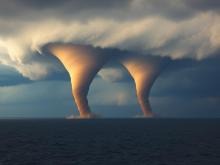A UBC Science astronomer has produced the most detailed images of deep space from 12 billion years ago, revealing tens of thousands of newly discovered galaxies at the early stages of formation.
Recently presented at the first International Herschel Science Meeting in Spain, the images by UBC post-doctoral fellow Gaelen Marsden use data from the European Space Agency's Herschel Space Observatory. The striking images paint a picture of the Universe just one billion years after the Big Bang, when the Universe was a thriving nursery of newly-formed stars.
"These images allow us to see 10 times more galaxies than ever before and with stunning clarity," says Marsden, who has spent the past few years working on similar but lower-resolution images from previously collected data.
"It's incredibly rewarding to see the high sensitivity and resolution that the new Herschel data have enabled. They allow us to take a close look at the stars during early and vital stages of formation, and could change the way we study formation in the future."
Herschel is the largest and most expensive space telescope ever built. It is equipped with three infrared cameras: SPIRE, PACS and HIFI.
Images taken at these far-infrared wavelengths show where the stars are forming in all the galaxies in that part of space. Pictures taken at optical wavelengths, even those taken by the new camera on the Hubble Space Telescope, miss regions hidden by cosmic dust, which is about half of the total starlight.
Data collected by Herschel are being analysed by the programme’s biggest research project, the Herschel Multi-tiered Extragalactic Survey (HerMES). The project consists of more than 100 astronomers from six countries, including UBC Astronomy Professors Mark Halpern and Douglas Scott and post-doctoral fellows Ed Chapin, Marsden, Elisabetta Valiante and Don Wiebe.
The HerMES project aims to produce a map of the Universe as it was as far back as 12 billion years ago and is expected to discover hundreds of thousands of new galaxies at early stages of their formation. The first results from the HerMES survey come from the SPIRE camera, in which Canadians are involved through the support of the Canadian Space Agency (CSA).
The SPIRE infrared camera is capable of peering into the coldest dust clouds to see the most distant sites of star formation. Its three filters allow for a colour composite image to be made, where the colour indicates the temperature of the region. This allows astronomers to learn about the physical conditions in some of the most distant sites of star formation and untangle the mysteries of how the first stars formed.
“Seeing such stunning images after just 14 hours of observations gives us high expectations for the full length observations over much larger regions of the Universe,” says Seb Oliver, a U.K. lead in the project. “This will give us a much clearer idea of how star formation has progressed throughout the history of the Universe.”
This survey was preceded by the successful BLAST project, the Antarctic balloon experiment that inspired a full-length documentary “BLAST! The Movie.” BLAST used a replica of the SPIRE camera and provided a glimpse of what was to come.
"While BLAST provided exciting results, the ability to go into space for an extended period of time allows for much more ambitious surveys of the distant Universe,” says Scott, part of the CSA-funded UBC BLAST team. “The Herschel telescope has the biggest mirror to be launched into space, and this provides images which are less blurred than those collected by BLAST."
A major goal of the Herschel mission is to discover how galaxies were formed and how they evolved to give rise to present-day galaxies like our own Milky Way Galaxy.
Professors Halpern and Scott of UBC's Department of Physics and Astronomy are experts in understanding galaxy formation through using far-infrared, millimetre wavelength and microwave radiation and will actively participate in the HerMES project as it produces more results.
"We chose to feature these images first because they show what we believe is the most important result in the initial science release of this satellite – and the key to the early star formation history of the Universe," says Halpern.
More information:
Spire Site
http://research.uleth.ca/spire
HerMES Site
www.hermes.sussex.ac.uk
Musqueam First Nation land acknowledegement
We honour xwməθkwəy̓ əm (Musqueam) on whose ancestral, unceded territory UBC Vancouver is situated. UBC Science is committed to building meaningful relationships with Indigenous peoples so we can advance Reconciliation and ensure traditional ways of knowing enrich our teaching and research.
Learn more: Musqueam First Nation
Faculty of Science
Office of the Dean, Earth Sciences Building2178–2207 Main Mall
Vancouver, BC Canada
V6T 1Z4


